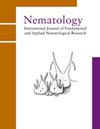Pristionchus seladoniae n. sp.(Diplogastridae),从日本长野的一种社会性土栖蜜蜂 Halictus (Seladonia) aerarius 身上分离出来
IF 1.2
4区 生物学
Q2 ZOOLOGY
引用次数: 0
摘要
从日本长野县菅平市采集的土栖蜜蜂 Halictus (Seladonia) aerarius 身上分离出一种新的 Pristionchus。在线虫生长培养基琼脂上成功地培养出了这种线虫,并接种了大肠埃希氏菌 OP50 菌株。从类型学上看,该新种与属于 maupasi、pacificus 和 lheritieri 类的其他 Pristionchus 类似,都是气孔结构呈气孔状。不过,该物种的特点是雌性尾部相对较短,呈圆锥形,雄性生殖器乳头的排列方式为第二对和第三对乳头几乎处于同一水平,其中一个乳头向侧面伸展。在系统发育上,该线虫属于 maupasi 群,是该属中的 "美洲支系",可与该群中的其他物种区分开来。在生物学上,该物种有几个有趣的特征:无论其系统发育群如何,它似乎都是日本的原生种;它与一种雌性蜜蜂有紧密而特殊的寄生关系;在培养条件下,它缺乏雌雄同体的形式(或这种形式很少出现);它在培养基上表现出特征性的结块行为。该新种在分类学上被描述为 Pristionchus seladoniae n. sp.本文章由计算机程序翻译,如有差异,请以英文原文为准。
Pristionchus seladoniae n. sp. (Diplogastridae) isolated from a eusocial soil-dwelling bee, Halictus (Seladonia) aerarius, in Nagano, Japan
A new species of Pristionchus was isolated from a soil-dwelling bee, Halictus (Seladonia) aerarius, collected from Sugadaira, Nagano, Japan. The nematode was successfully cultured on nematode growth medium agar previously inoculated with the Escherichia coli strain OP50; however, it did not propagate well. Typologically, the new species is similar to other Pristionchus belonging to the maupasi, pacificus and lheritieri groups in the stomatal structure of stenostomatous form. However, the species is characterised by the relatively short, conical tail of the female and the arrangement of male genital papillae in which the second- and third-paired papillae are almost at the same level and one of these two are directed laterally. Phylogenetically, the nematode belongs to the maupasi group, the ‘American clade’ within the genus, and is separable from the other species in the group. Biologically, the species has several interesting characters: it is seemingly native to Japan, regardless of its phylogenetic group; it is in tight and specific phoretic association with a eusocial bee; it lacks a eurystomatous form (or this form occurs rarely) under cultured conditions; and it shows characteristic clumping behaviour on culture media. The new species is taxonomically described herein as Pristionchus seladoniae n. sp.
求助全文
通过发布文献求助,成功后即可免费获取论文全文。
去求助
来源期刊

Nematology
生物-动物学
CiteScore
2.60
自引率
33.30%
发文量
67
审稿时长
3 months
期刊介绍:
Nematology is an international journal for the publication of all aspects of nematological research (with the exception of vertebrate parasitology), from molecular biology to field studies. Papers on nematode parasites of arthropods, and on soil free-living nematodes, and on interactions of these and other organisms, are particularly welcome. Research on fresh water and marine nematodes is also considered when the observations are of more general interest.
Nematology publishes full research papers, short communications, Forum articles (which permit an author to express a view on current or fundamental subjects), perspectives on nematology, and reviews of books and other media.
 求助内容:
求助内容: 应助结果提醒方式:
应助结果提醒方式:


